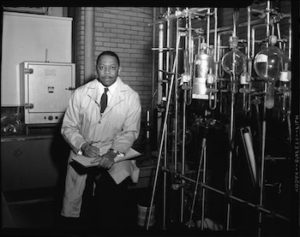
Moddie Taylor (Smithsonian)
*Moddie Taylor was born on this date in 1912. He was a Black chemist.
From Nymph, Alabama, Moddie Daniel Taylor was the son of Herbert L. Taylor and Celeste (Oliver) Taylor. His father worked as a postal clerk in St. Louis, Missouri, and it was there that Taylor went to school, graduating from Charles H. Sumner High School in 1931. He then attended Lincoln University in Jefferson City, Missouri, and graduated with a B.S. in chemistry in 1935 as valedictorian and summa cum laude student. He began his teaching career in 1935, working as an instructor until 1939 and then as an assistant professor at Lincoln University from 1939 to 1941. He also enrolled in the University of Chicago's graduate program in chemistry. He received his M.S. in 1939 and his Ph.D. in 1943.
Taylor married Vivian Ellis on September 8, 1937, and they had one son, Herbert Moddie Taylor. It was in 1945 that Taylor began his two years as an associate chemist for the top-secret Manhattan Project based at the University of Chicago. Taylor's research interest was in rare earth metals (elements that are the products of oxidized metals with special properties and several important industrial uses); his chemical contributions to the nation's atomic energy research earned him a Certificate of Merit from the Secretary of War. After the war, he returned to Lincoln University until 1948, when he joined Howard University as an associate professor of chemistry. He became a full professor in 1959 and head of the chemistry department in 1969.
In 1960, Taylor's First Principles of Chemistry was published; the Manufacturing Chemists Association, as one of the nation’s six top college chemistry teachers, selected him. In 1972, Taylor was also awarded an Honor Scroll from the Washington Institute of Chemists for his contributions to research and teaching. Taylor was a member of the American Chemical Society, the American Association for the Advancement of Science, the National Institute of Science, the American Society for Testing Materials, the New York Academy of Sciences, Sigma Xi, and Beta Kappa Chi, and was a fellow of the American Institute of Chemists and the Washington Academy for the Advancement of Science. Taylor retired as a professor emeritus of chemistry from Howard University on April 1, 1976, and died of cancer in Washington, D.C., on September 15, 1976.